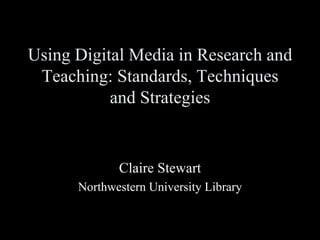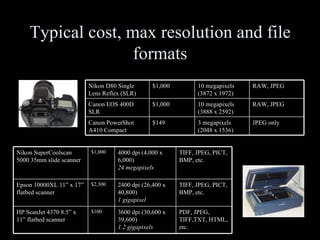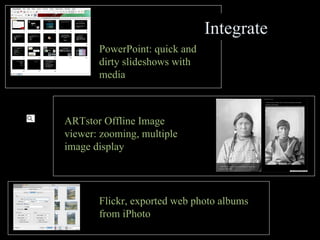Using digital media in research and teaching: standards, techniques and strategies
- 1. Using Digital Media in Research and Teaching: Standards, Techniques and Strategies Claire Stewart Northwestern University Library
- 2. Two problems Teaching with pictures Creating and managing interview audio and document scans ĪŁ and a bit about file sizes
- 3. Problem 1: Teaching with pictures Locate or acquire Locate: ARTstor, Visual Media Collection, Google image search, etc. Acquire: Camera or scanner? Adjust and enhance Adjust/edit: Photoshop for touchups, file format conversion Enhance: Add your own description, notes Integrate Presentation and dissemination: Powerpoint, ARTstor offline viewer, Keynote, web photo album, flickr
- 5. Acquire images When is it appropriate to use a digital camera? When is a scanner a better choice?
- 6. Image resolution Expressed in dots per inch (dpi) or overall pixel dimensions Height in inches x dots per inch = height in pixels
- 7. 2Ī» high detail at 600 pixels high for PowerPoint 1. A 1.5Ī▒ high 35mm slide of entire 50Ī» high wall 2. Scan at 10000 dpi to achieve an image 15,000 pixels high 3. Trim to 600 pixels high 1. A 5Ī▒ high print of 2Ī» high detail 2. Scan at 120 dpi to achieve an image 600 pixels high OR
- 8. Typical cost, max resolution and file formats JPEG only 3 megapixels (2048 x 1536) $149 Canon PowerShot A410 Compact RAW, JPEG 10 megapixels (3888 x 2592) $1,000 Canon EOS 400D SLR RAW, JPEG 10 megapixels (3872 x 1972) $1,000 Nikon D80 Single Lens Reflex (SLR) PDF, JPEG, TIFF,TXT, HTML, etc. 3600 dpi (30,600 x 39,600) 1.2 gigapixels $100 HP ScanJet 4370 8.5Ī▒ x 11Ī▒ flatbed scanner TIFF, JPEG, PICT, BMP, etc. 2400 dpi (26,400 x 40,800) 1 gigapixel $2,300 Epson 10000XL 11Ī▒ x 17Ī▒ flatbed scanner TIFF, JPEG, PICT, BMP, etc. 4000 dpi (4,000 x 6,000) 24 megapixels $1,000 Nikon SuperCoolscan 5000 35mm slide scanner
- 9. Camera vs Scanner Better resolution, but oversize originals may pose challenges If text or lines are small, resolution may not be sufficient Oversize maps Even illumination, higher resolution capture If text is small, resolution may not be sufficient Printed documents Scan from a slide or print for better resolution, but color fidelity may be an issue Grab a snapshot passing through, or make arrangements with curator Art hanging in a museum N/A On the spot capture Group excursion or live performance Scanner Camera
- 10. Use a screen capture utility! Built in to Mac command( ? )-3 and command-4 Built in to Windows alt-prnt screen to copy to the clipboard Standalone utilities Mac: SnapZPro Windows: Snagit/Camtasia others: www.versiontracker.com or www.tucows.com .
- 11. Adjust and enhance Photoshop,Photoshop Elements, iPhoto, Microsoft PhotoEditor for touchup, resize and file conversion Change title, description, add notes and other metadata in Photoshop, Windows Explorer, iPhoto, etc.
- 12. Integrate PowerPoint: quick and dirty slideshows with media ARTstor Offline Image viewer: zooming, multiple image display Flickr, exported web photo albums from iPhoto
- 13. PowerPoint defaults to sizing images roughly according to their print size. These two images are identical in overall pixel dimension, but the above image is set to print at 1Ī▒ by 1.6Ī▒, while the one on the right is set to print at 4Ī▒ by 6Ī▒ Pay attention to overall pixel size, and override PowerPointĪ»s default sizing behavior PowerPoint tip
- 14. Problem 2: Creating and managing interview audio and document scans Find the right hardware Handheld audio recorder or professional studio hardware Digital camera with tripod and extender arm, or inexpensive scanners Create a workflow that makes sense Back up your data! Go just fast enough to still be safe Perform OCR or transcribe audio Find a tool to help organize data Irfanview, Qpict, iView Media pro, iPhoto
- 15. Audio hardware Handheld/portable audio recorders $50 - $300 May be platform- or file-format specific (DSS file format less universal than WAV, MP3) Look for USB connections or Compact Flash Standalone studio microphones and digital recorders Better sound quality, more expensive More complex interfaces
- 16. Gathering document facsimiles Poor lighting, handheld digital camera Better lighting, camera on tripod with extender arm Image courtesy Heather Schoenfeld Image courtesy Christopher Hayden
- 17. Gathering document facsimiles Extender arm for tripod: essential if using a digital camera Pen scanner: an emerging pocket-sized device
- 18. Create a workflow Go slowly enough that you can make sure your data is safe Back it up!
- 19. Post-processing your data Image to text: Optical Character Recognition (OCR) software (OmniPage) Audio to text: iListen, viaVoice, Audio transcription software (Transcriber)
- 20. Find a tool to manage data Shown: iView Media Pro
- 21. ĪŁ and a bit about file sizes and quality File size (generally) increases as quality increases Never try to go from less resolution/lower quality to high. Always go high to low.
- 22. 5.6 megabytes per minute of video at a data rate of 750 kilobits per second. Digital video file format with variable compression. Good for network delivery. MPEG4 187 megabytes per minute of video at a data rate of 25 megabits per second. Digital video file format with variable data rate. Usually for editing, not good for network delivery.Typically the file format used by iMovie, FinalCut, and other digital video editing software. DV 960 kilobytes per minute of audio at a data rate of 128 kilobits per second. Audio file format, usually highly compressed. Good for network delivery. MP3 10 megabytes per minute of audio at CD quality (44 kHz, 16-bit) Audio file format with optional compression. Good for long-term archiving. WAV File sizes will vary depending on amount of compression; 50 - 300 kilobytes typical for web delivery Image file format with variable compression. Good for web delivery and screen presentation. Can be displayed by all web browsers. JPEG 8.5 x 11 scan, 150 dpi, 24-bit color: 6 megabytes Image file format with optional compression. Good for printing and long-term archiving. TIFF
- 23. Contact me any time M Claire Stewart Northwestern University Library 847-467-1437 AIM:claireystew [email_address] http://www.library.northwestern.edu/cstewart























![Contact me any time M Claire Stewart Northwestern University Library 847-467-1437 AIM:claireystew [email_address] http://www.library.northwestern.edu/cstewart](https://image.slidesharecdn.com/using-digital-media-in-research-and-teaching-standards-techniques-and-strategies-18362/85/Using-digital-media-in-research-and-teaching-standards-techniques-and-strategies-23-320.jpg)